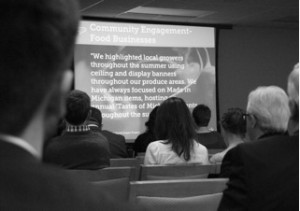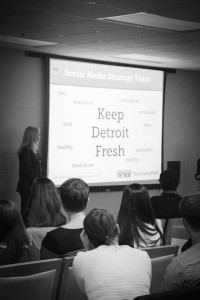Our first challenge as Year Three Fellows partnered us with RecoveryPark, a non-profit organization dedicated to creating jobs for Detroiters with barriers to employment (e.g. low literacy levels, recovering addicts, returning citizens). By converting blighted land into urban agriculture and aquaculture ventures, and growing a family of value-added food production businesses, RecoveryPark plans to create over 1,000 jobs in the next ten years which will help grow Detroit’s ‘local-live-fresh’ food movement.
Currently RecoveryPark is in the final stages of land acquisition (110 acres surrounding Detroit’s historic Chene-Ferry Market) from the City of Detroit. As this draws to a close, reengaging the community in and around the RecoveryPark ‘footprint’ (the acquired land) is critical.
To assist RecoveryPark in its mission, we, the fellows, were asked:
How might we utilize different mediums to creatively communicate the mission and vision of RecoveryPark, and strategize for the coordination of future stakeholder (community members, businesses, city partners, non-profit partners etc.) engagement?
 Furthermore, all of our work had to keep in mind the overarching goals for the project:
Furthermore, all of our work had to keep in mind the overarching goals for the project:
- Engage an otherwise disenfranchised and fragmented community in RecoveryPark development initiatives
- Creatively capture and publish the community’s input
- Develop collateral pieces (graphics, info-graphics, videos, pamphlets etc.) that tell RecoveryPark’s story in the community context
- Design an engaging social media strategy to establish the digital identity of RecoveryPark
- Utilize the data to drive project design
 In response, we developed inspirational creative work, amazing social media campaigns, and a variety of strategies to better engage the local community and restaurants. One such strategy focused on volunteer engagement to bring the Chene-Ferry Market back to life. Another included detailed renderings of the possibilities for the footprint. Most importantly, all ideas focused on community participation, a pillar for this particular project. It was, and is, critical for RecoveryPark to ensure that every voice of neighbors is heard and included in the development of the Market and entire neighborhood development plan. For an in-depth discourse on how we completed our first challenge, read this blog by fellow Annie Hakim.
In response, we developed inspirational creative work, amazing social media campaigns, and a variety of strategies to better engage the local community and restaurants. One such strategy focused on volunteer engagement to bring the Chene-Ferry Market back to life. Another included detailed renderings of the possibilities for the footprint. Most importantly, all ideas focused on community participation, a pillar for this particular project. It was, and is, critical for RecoveryPark to ensure that every voice of neighbors is heard and included in the development of the Market and entire neighborhood development plan. For an in-depth discourse on how we completed our first challenge, read this blog by fellow Annie Hakim.
In terms of how it felt to complete our first challenge, it was… challenging. We had to work around obstacles and time constraints. We had to step outside what we know and try something new. Perhaps that’s where learning happens. And, of course, worthwhile projects demand worthwhile effort. This was definitely worth the effort.
